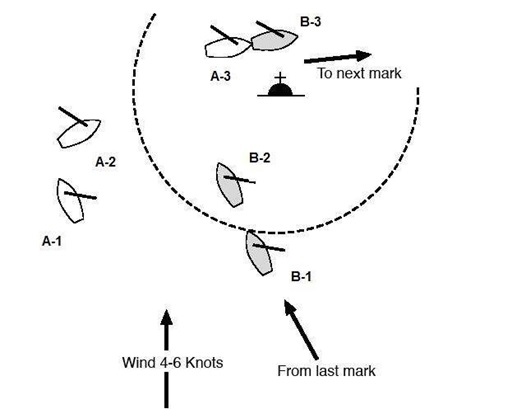



CASE 2
Rule 12, On the Same Tack, Not Overlapped
Rule 14, Avoiding Contact
Rule 15, Acquiring Right of Way
Rule 18.2(a), Mark-Room: Giving Mark-Room
Rule 18.2(b), Mark-Room: Giving Mark-Room
Rule 43.1(c), Exoneration
If the first of two boats to reach the zone is clear astern when
she reaches it and if later the boats are overlapped when the
other boat reaches the zone, rule 18.2(a), and not rule
18.2(b), applies. Rule 18.2(a) applies only while boats are
overlapped and at least one of them is in the zone.

Facts
A and B were both on port tack, reaching to a mark to be left to starboard.
The wind was light. At position 1, when A came abreast of the mark she
was clear ahead of B but four-and-a-half hull lengths from the mark. B,
which had just reached the zone, was three lengths from the mark. Between
positions 1 and 2 A gybed and headed to the mark, becoming overlapped
outside B. Between positions 2 and 3, after B had gybed and turned towards
the next mark, she became clear ahead of A. When B first became clear
ahead of A there was about one-half of a hull length of open water between
the boats. A few seconds after B became clear ahead, A, who was moving
faster, struck B on the transom. There was no damage or injury. A protested
B under rule 18.2(b). B protested A under rule 12. A was disqualified and
she appealed.
Decision
A apparently believed that the second sentence of rule 18.2(b) applied when
the two boats were at position 1 and that B, then being clear astern, was
obliged to give A mark-room. As that sentence states, it applies only if a
boat was clear ahead when she reached the zone. At position 1, B had
reached the zone, but A was well outside it. Moreover, the first sentence of
rule 18.2(b) never applied because the boats were not overlapped when B,
the first of them to reach the zone, did so. However, while the boats were
overlapped, rule 18.2(a) did apply, and it required A to give mark-room to
B. During that time B had to keep clear of A, first under rule 10 and later
(after she gybed) under rule 11.
After B gybed she pulled clear ahead of A. At that moment rules 18.2(a) and
11 ceased to apply and rules 12 and 15 began to apply. Rule 15 required B
initially to give A room to keep clear, and B did so because it would have
been easy for A to keep clear by promptly bearing off slightly to avoid B’s
transom after B became clear ahead. When A hit B’s transom, she obviously
was not keeping clear of B, and so it was proper to disqualify A for breaking
rule 12. A also broke rule 14 because it was possible for her to bear off
slightly and avoid the contact with B.
After it became clear that A was not going to keep clear of B, it was probably
not possible for B to avoid the contact. However, even if B could have
avoided the contact but did not do so, she would have been exonerated by
rule 43.1(c) because she was the right-of-way boat and the contact did not
cause damage or injury.
The appeal is dismissed, the protest committee’s decision is upheld, and A
remains disqualified for breaking rules 12 and 14.
USA 1962/87






